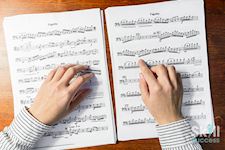Music Theory Comprehensive Part 1: How To Read Music
Skill Success
Summary
- Certificate of completion - Free
- Tutor is available to students
Add to basket or enquire
Overview
In this course, you will learn how to read music using proven techniques, understand all the symbols of a music score, and read, play, and count rhythms accurately. By taking this course today, you will learn how to read music.
Benefits of taking this course include:
- Unlimited and lifetime access to the course
- Learn the course at your own pace
- Course can be accessed on any platform
- 24/7 Customer support
Course media
Description
For years I’ve been teaching Music Theory in the college classroom. These classes use the same syllabus I’ve used in my college classes for years, at a fraction of the cost. I believe anyone can learn Music Theory – and cost shouldn’t be a barrier.
Recently I was named as a semi-finalist for the Grammy Foundation’s Music Educator of the Year award because of my in-person university classes. Now I’m taking those classes in an online format in order to reach more students, and give them the joy of Music Theory.
This class is a Comprehensive class – it will have many parts, going through my entire annual curriculum.
In this class, we will cover:
- My approach to Music Theory
- Tools you will need to learn Music Theory quickly and efficiently
- Music software: Notation programs
- The elements of the Score
- Pitch Names
- Pitch Classes
- Octaves
- The White Keys
- The Black Keys (not the band!)
- Half-Steps and Whole-Steps
- Clefs
- Intervals
- Naming Octaves
- Identifying Notes on the Staff
- Identifying Notes on the Keyboard
- Beat and Beat Divisions
- Tempo
- Downbeats and Upbeats
- Dotted Rhythms
- Time Signatures
- Ties
- Accidentals
- Form in Music Notation
- …and much, much more!
Music Theory Comprehensive Part 1: How To Read Music course will cover the following topics:
Topic 1 - Getting Started
- Introduction
- My Approach To Music Theory
- Tools You Will Need For This Course
- Staff Paper
- About Notation Software Programs
Topic 2 - All The Little Dots
- The Elements Of The Score
- Pitch Names
- Pitch Classes
- Octaves
- Worksheet No. 1
Topic 3 - The Keyboard Layout
- Why We Use A Keyboard
- The White Keys
- The Black Keys (Not The Band…)
- Half-steps And Whole-steps
- A Little Review Of What We’ve Learned So Far
- Worksheet No. 2
Topic 4 - Pitch Notation On The Staff
- Staff Overview
- Clefs
- Treble Clef Refresher
- Naming Notes And Intervals
- Octave Names
- Worksheet No. 3
Topic 5 - Organizing Time In Music Notation
- Beat And Beat Divisions
- Duple Vs. Triple
- Tempo, Downbeats, And Upbeats
- Worksheet No. 4
Topic 6 - Notating Time On A Musical Staff
- Rhythmic Subdivisions
- Dots
- Rests
- Time Signatures
- Ties
- Languages
- Worksheet No. 5
Topic 7 - Score Symbols And Conventions
- Dynamics And Repeats
- Accidental Behavior And Naturals
- Form
- Worksheet No. 6
Topic 8 - Putting It All Together
- Places To Find Scores Online
- Tips For Practicing Notes And Rhythms
- A Bunch Of Practice Music!
Topic 9 - Wrap Up
Who is this course for?
This course is designed for anyone who is interested in learning how to read music.
Requirements
No prior knowledge is required to take this course.
Questions and answers
Currently there are no Q&As for this course. Be the first to ask a question.
Certificates
Certificate of completion
Digital certificate - Included
Reviews
Legal information
This course is advertised on reed.co.uk by the Course Provider, whose terms and conditions apply. Purchases are made directly from the Course Provider, and as such, content and materials are supplied by the Course Provider directly. Reed is acting as agent and not reseller in relation to this course. Reed's only responsibility is to facilitate your payment for the course. It is your responsibility to review and agree to the Course Provider's terms and conditions and satisfy yourself as to the suitability of the course you intend to purchase. Reed will not have any responsibility for the content of the course and/or associated materials.


